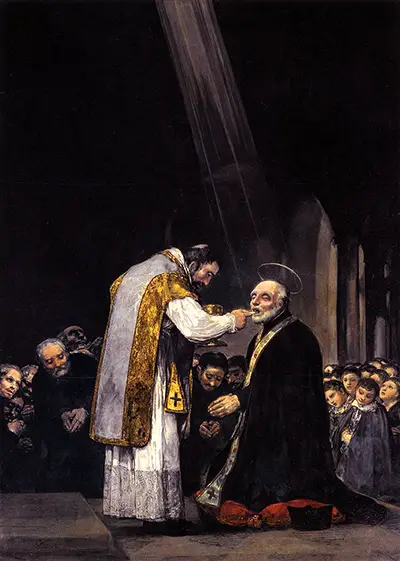This delightful piece was completed by Francisco de Goya in 1819 during an important period in Spanish art. It was to be hung at the Saint's Chapel.
The painting is believed to have been one of the artist's final religiously-themed artworks and captures some strong emotions which make this piece so memorable. One can notice straight away the shards of light that reach down from above onto the elderly man, who himself has a halo floating just above his head. The figure carrying out the communion is beautifully dressed in traditional robes which Goya is careful in depicting accurately. Every last detail is included, with ripples of material and patterns of colour that bring the outfit to life. Behind them is a large group of figures who watch on in a variety of reactions, most common of which was an excitement at proceedings as well as a sharp focus. Goya did not make use of religious themes as much as earlier painters from the 16th and 17th century but would still visit it on occasion, often when a high paying patron required him to do so.
Goya was well aware of his limitations at around this time. He declared that only a few more artworks would come from his hand after this one and he would then spend most of his remaining years living in Bordeaux, France because of his feeling of insecurity within Spain. He rarely returned to his native country during that period, and would do so only for specific tasks and then return immediately once they were complete. He also had a grandson of whom he was very fond and would make great efforts to see him, even though he was elderly and particularly ill by this point. He would later leave his grandson his house in Spain as well as signficant financial backing for his future. It is always surprising to see the contrast of his kindness, whilst also producing so many dark artworks in the latter part of his career, including his series of Black Paintings that adorned the walls of his own home like an expressive mural.
The artist carefully planned The Last Communion of St Joseph of Calasanz to be entirely suitable for the location in which it hangs. The spot is fairly dark itself, with candle light bringing attention to the two key figures of this composition. He essentially chose the lighting within the painting to match where it was later to be displayed, though it is somewhat of a shame that most people are unable to view this piece up close. Thankfully, Goya was an exceptionally productive artist, producing hundreds of artworks in several different mediums across his lifetime, constantly striving to continue onwards, despite considerable health problems. This large output ensures that many in the western world are still very much able to see some of these artworks in person.




